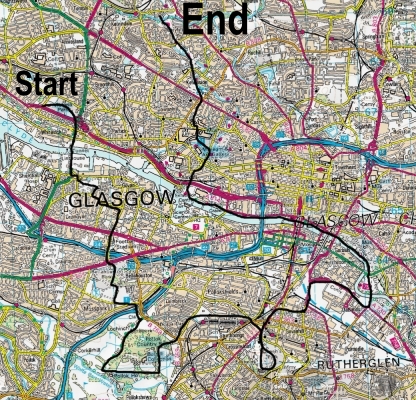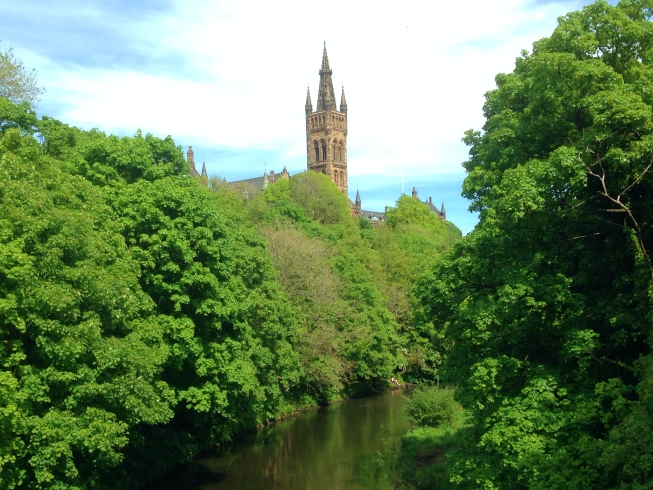
Glasgow Parks Cycle Ride
This is more a suggestion of a theme for a cycle ride than a description of a clearly defined cycle route. Despite being entirely within a city setting, most of the route is on dedicated cycle routes or cycle lanes. There are a few points where improvisation and on street cycling is required. The map below is just to give a general impression of where we went rather than to give the detail of the route. Glasgow has more than 90 parks so you can put together any number of variations on the route that we followed. I hope that this description and the pictues and video inspire you to visit some of Glasgow's parks on your bike.

We started in Victoria Park which a is very pretty park in the west of the city with a pond and 330 million year old fossilised trees. The park was opened in 1887 just after Queen Victoria's Jubilee and after whom the park is named.
We then
travelled South via the Clyde Tunnel which surfaces in Govan which
was home to Fairfield Shipping and Engineering Company. When its
founder died his wife donated a park in his memory. Their name was
Elder and Elder Park is an oasis of green in an otherwise very
industrial setting.
A bit further south you come to Bellahouston Park and it is home to Charles Rennie Mackintosh’s House for an Art Lover. The 1938 Empire Exhibition was held in the park with 200 palaces and pavilions being built. 12 million people paid one shilling to visit the exhibition and the only remaining palace is the Palace of Art. The park also has an artificial ski slope and was the venue for the Pope’s visit to Scotland on 1st June 1982. He held mass for 300,000 people in the park that day and set a record for the biggest ever assembly of people in Scotland.
Further South again, you come to Pollok Park which is the largest of Glasgow’s parks and was voted best park in Europe in 2008. It is home to the Burrell Collection which houses 8,000 items collected by Sir William Burrell a wealthy shipping magnate. Pollok House, built in 1752, is also in Pollok Country Park and is now owned by the National Trust for Scotland.
Northwards beyond Pollok Park in the affluent suburb of Pollokshields, you will find Maxwell Park which was donated to the city in 1890 by Sir John Stirling Maxwell, a Scottish politician and philanthropist.
Slightly to the east, in Langside, you will find Queen’s Park. The park is on the site of the Battle of Langside and is dedicated to the memory of Mary Queen of Scots. From its highest point you have a marvellous panoramic view of the city.
Crossing the River Clyde northwards by using the St. Andrews suspension bridge, you will find yourself in Glasgow Green which is Glasgow’s oldest park. There you will find the Doulton Fountain, the largest terracotta fountain in the world. The Winter Gardens is a huge glasshouse where you can stroll among tropical plants and the People’s Palace is a museum dedicated to Glasgow’s rich history.
Kelvingrove Park and the Botanic Gardens are in the west end of the city and are both spectacular examples of beautifully maintained public spaces and we got there by following the Clyde along The Broomielaw. On the way you pass The Hydro and The Armadillo just across the river from The Science Centre and its tower.

ronnie@outandaboutinscotland.co.uk
24th May 2020